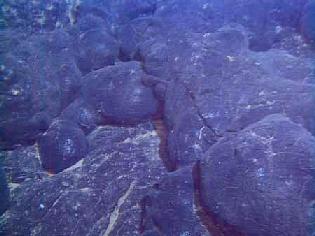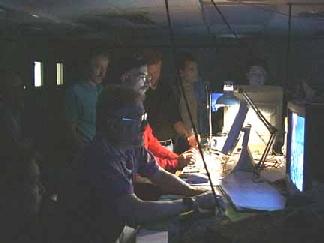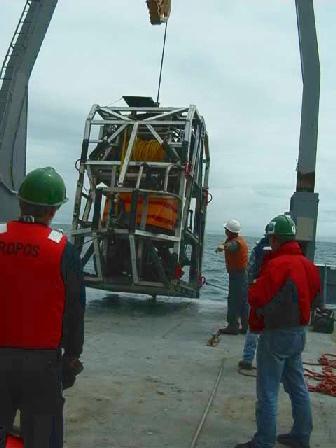WHAT'S NEW:
BACKGROUND:
Mission
Project Description
Cruise Plans:
Participants
Technology (ROV, ships, etc.)
Future Plans
Results:
1998 NeMO Cruise
Axial 1998 "Eruption"
Logbook
July 3, 1999
July 3, 1999
Contents:
- News from Thompson
- Participant Perspective
- Logbook from Teacher at Sea
- Question/Answer from shore to sea
Thompson Science Report
Science update...

Dive 493 in progress at southern extent of 1998 lava flow. Photo shows new lava flowing onto the old lava (old lava in lower left corner). |
Note: Scientists are very busy during this Dive and can not send a full
report at this time. Evidently they have made some very exciting
discoveries which they will report on in the next few days.
NeMO Webmaster
Listing of all Science News postings
Life at Sea: Participant Perspective
Mike Dempsey
Canadian Scientific Submersible Facility
 I have been working
as a mechanical tech with the ROPOS ROV
for almost three years. Like all the ROPOS crew, I have specialized training,
but in practice am a generalist. In the course of a cruise I may be maintaining
the vehicle, repairing cabling, providing acoustic
navigation, making new brackets for installing equipment, assisting
with the manipulators or doing a little relief piloting. My path to the
world of scientific research by ROV has many bends. The bends in lifes
road are what make it interesting to me. I started out as a biological
oceanographic technician and then branched out into supporting physical,
chemical and geological oceanographic research as well. As well as assisting
in data collection, I began to modify and design pieces of oceanographic
equipment. It seemed there was never enough of one thing, but that didnt
matter because I liked the variety. There was always someone asking
I have been working
as a mechanical tech with the ROPOS ROV
for almost three years. Like all the ROPOS crew, I have specialized training,
but in practice am a generalist. In the course of a cruise I may be maintaining
the vehicle, repairing cabling, providing acoustic
navigation, making new brackets for installing equipment, assisting
with the manipulators or doing a little relief piloting. My path to the
world of scientific research by ROV has many bends. The bends in lifes
road are what make it interesting to me. I started out as a biological
oceanographic technician and then branched out into supporting physical,
chemical and geological oceanographic research as well. As well as assisting
in data collection, I began to modify and design pieces of oceanographic
equipment. It seemed there was never enough of one thing, but that didnt
matter because I liked the variety. There was always someone asking
"Do you think you could do this?"
"I don't know. I've never done it before. Why not?," I answered perhaps a
few times more than was healthy.
Everyday working with the ROPOS there is something new. The scientists involved are always investigating and exploring new ideas, and there is a feeling of discovery on every cruise. At hydrothermal vents, even though research has been conductive for 20 years, something new is encountered on every cruise. Perhaps it is a new species of animal, hot water where it is not expected or the fresh lava flow of a volcano 1500 metres below the surface. I was trained to sample from a ship using nets and bottles lowered blindly thousands of metres below the surface and to tow instrumentation on a wire through the water column. The ocean seemed very large when we only captured small glimpses of it in bottles and or on narrow transects. There is something very attractive to being able to see and sample the water, fauna or ocean floor selectively. One of my favourite ways on shore of observing sea life is to sit on the rocks at the beach near my home, and watch Sharp Nose Crabs crawling in amongst the seaweed and barnacles. I watched their interaction and feeding for many hours. I get the same feeling with ROPOS while watching the monitor as a Vent crab crawls through fields of tubeworms.
It is also the variety of research and technologies involved that make working ROPOS interesting to me. The vehicle is set up as a versatile work platform that allows the researcher to add an unlimited range of sensors and samplers. A broadcast quality 3-chip colour camera allows the researcher the ability to make detailed video surveys of a deep ocean world far removed from the light of day. The two manipulators make a powerful team to deploy equipment and selectively sample on the bottom. The Scientific Telemetry System (STS) and science junction box allow the researcher to bring their sensors and plug them in. The system is rapidly configurable and can accommodate up to 8 serial instruments using RS232 or 422 at 9600 baud with a power supply of 12 or 24V and all that is needed is to bring a suitable 3 or 4 pin underwater connector with the package. With a change of ballast weight ROPOS can accommodate many sensors or samplers on a dive. For one set of dives last year we had over 300 pounds of scientific payload including an Imagenex sonar mapping system, a digital still camera with twin strobes, the SUAVE analyser, a biological sample box, two gas tight sampling bottles and two Niskin samplers.
Above all it is working with the ROPOS crew that is most enjoyable. There is constant innovation and creativity that goes into every dive. Sometimes a piece of equipment is broken and needs to be repaired when there are not the right materials. Quite often, the conditions encountered are different than expected and we must develop new tools or techniques for the job. We make use of whatever is at hand and make it work. Everyone has particular skills to contribute and the combination of varied experience is very effective. Working in this environment is always exciting and makes the unexpected a more enjoyable experience.
Listing of all Perspectives postings
Teacher At Sea Logbook
Teacher Log #13 7/13/99

Scientists viewing dive progress and collaborating during dive 493 in the main ROPOS control laboratory. |
You'll find on this cruise a number of scientists, technicians and crew that have spent time on cruises where a manned submersible was used. Three of the ROPOS technicians have actually piloted them in the past (they'll say they flew them). For a time, this was the main tool used for getting information about the seafloor. One disadvantage of this type of submersible is limited space - they can carry a maximum of 3 people, 1 or 2 pilots and no more then 2 scientists. But what it loses in space it gains in its view of the ocean floor. The pilot of course has the best view in the house, but still, many will say that the view through a window beats the view on a monitor screen. You gain the advantage of three dimensional viewing that you just cant see in a monitor. This also aids in more efficient sampling. One disadvantage of a manned submersible is a decrease in bottom time due to a finite supply of oxygen.
 Remotely operated vehicles (ROV's) have been
on the rise for research on the ocean floor since the late 80s. There
are now over 500 working class (ocean going) ROVs in the world today,
supported by numerous countries and special interest groups. The first
one used out on the Juan de Fuca ridge was "Jason"
in 1991. The original ROPOS first explored
these waters in 1992 before it was lost is a storm in October of 1996.
The ROPOS we are now using is a veteran of many research dives all around
the world. What makes ROVs so valuable is their increased potential
bottom time. An ROV can actually spend an infinite amount of time
flying in the oceans depths. The length of the dive is primarily limited
by the number of samples it can carry, so in the case of seafloor mapping,
ROVs have the advantage of being able to run for an unlimited time period.
Once in the water, they are tireless work horses, and have a quicker turn
around time than a manned submersible (as ROPOS proved on the NeMO
cruise last summer with over 250 hours at the bottom in one month!).
When asked, scientists feel that the greatest appeal of an ROV is that
when it is on the sea floor, scientists from all fields can see the action
in real time on video screens (photo above left) and interact and discuss
the observations as well as give directions to the pilot. Discoveries
like we saw yesterday in the new lava flows, can be discussed while the
ROV is poised for direction. Sampling procedures can be debated and directions
can be given. That is science in action!
Remotely operated vehicles (ROV's) have been
on the rise for research on the ocean floor since the late 80s. There
are now over 500 working class (ocean going) ROVs in the world today,
supported by numerous countries and special interest groups. The first
one used out on the Juan de Fuca ridge was "Jason"
in 1991. The original ROPOS first explored
these waters in 1992 before it was lost is a storm in October of 1996.
The ROPOS we are now using is a veteran of many research dives all around
the world. What makes ROVs so valuable is their increased potential
bottom time. An ROV can actually spend an infinite amount of time
flying in the oceans depths. The length of the dive is primarily limited
by the number of samples it can carry, so in the case of seafloor mapping,
ROVs have the advantage of being able to run for an unlimited time period.
Once in the water, they are tireless work horses, and have a quicker turn
around time than a manned submersible (as ROPOS proved on the NeMO
cruise last summer with over 250 hours at the bottom in one month!).
When asked, scientists feel that the greatest appeal of an ROV is that
when it is on the sea floor, scientists from all fields can see the action
in real time on video screens (photo above left) and interact and discuss
the observations as well as give directions to the pilot. Discoveries
like we saw yesterday in the new lava flows, can be discussed while the
ROV is poised for direction. Sampling procedures can be debated and directions
can be given. That is science in action!
The next generation of underwater research vehicles is the Autonomous ROV. These untethered battery operated vehicles would replace the need to be on station in the ocean giving command from above. Imagine sitting in your lab back on land giving directions about what data you want collected. The technology is still a ways off, but the plans are in the works.
Bye for now.
Logbook of all Teacher At Sea postings
Questions & Answers
(oar.pmel.vents.webmaster@noaa.gov)